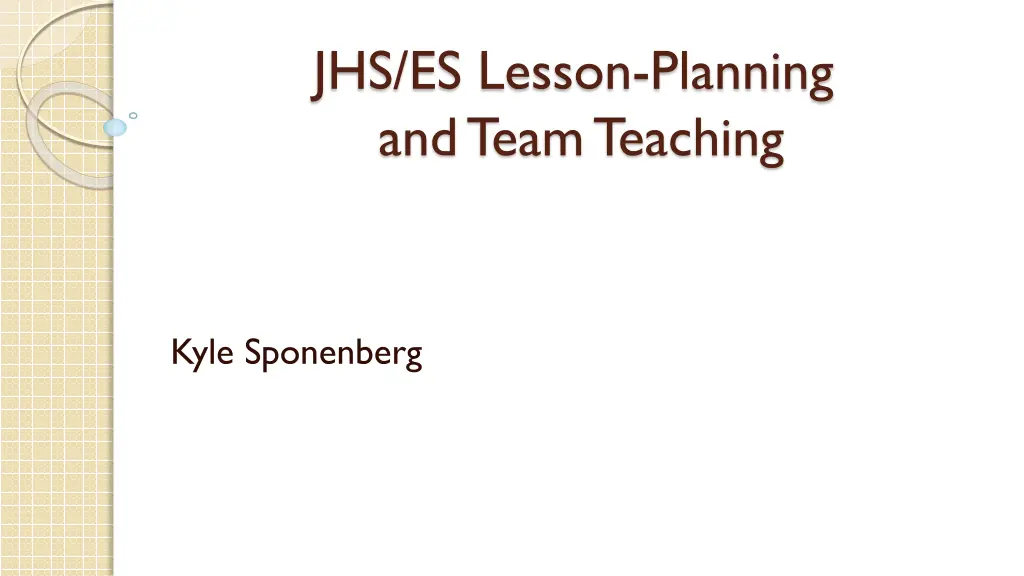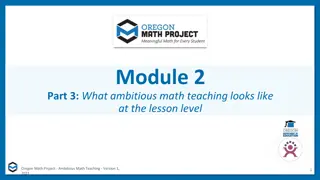
Effective Lesson Planning for JHS/ES Teachers
Learn how to plan engaging lessons effectively for Junior High School/Elementary School students with these four steps: finding class time, determining lesson content, creating a detailed plan, and reflecting for improvement. Explore a comprehensive lesson planning skeleton and essential considerations for successful planning.
Download Presentation

Please find below an Image/Link to download the presentation.
The content on the website is provided AS IS for your information and personal use only. It may not be sold, licensed, or shared on other websites without obtaining consent from the author. If you encounter any issues during the download, it is possible that the publisher has removed the file from their server.
You are allowed to download the files provided on this website for personal or commercial use, subject to the condition that they are used lawfully. All files are the property of their respective owners.
The content on the website is provided AS IS for your information and personal use only. It may not be sold, licensed, or shared on other websites without obtaining consent from the author.
E N D
Presentation Transcript
JHS/ES Lesson-Planning and Team Teaching Kyle Sponenberg
4 Steps to Effective Lesson Planning in JHS Step 1: Find out when you have class Step 2: Find out what you ll cover Step 3: Create the lesson plan Step 4: Iterate and improve
Step 1: Find out when you have class Your JTEs WILL be busy. It s your job to find a time to discuss lessons with them Also make sure to make yourself available Get a schedule well in advance. No one likes being surprised Schools make weekly schedules. Having one can be very helpful The schedule WILL change. Sometimes you just have to go with it
Step 2: Find Out What to Cover Lesson types Grammar points Reading practice Listening practice Conversation practice Cultural lesson Review Ask if the students have learned the material yet See if your JTE has suggestions or something specific in mind that they want to do
Step 3: Create the Lesson Plan Things to consider when planning: Class length 45 vs 50 min Activity time/lesson schedule Warm up activities Transitions Directions Materials Activity types JTE s role What period is the class Class attitude Class/activity goals
Step 4: Iterate and Improve Reflect on your lessons once you've finished What worked and what didn't? How did the class react? What does your JTE think about it? Use your self-introduction lesson as a testing ground. Make concrete changes- even if they're small Keep notes on all of your classes to help plan in the future. Iterate on lesson planning itself.
Lesson Plan Skeleton Greetings Warm-up Main Activity 1 Main Activity 2 (if necessary) Closing
Greetings Hello/Good morning/Good afternoon! How are you? I m ~ What day is today? It s ~ How is the weather? Classes usually have a set greeting in place
Warm-up Short activity Preferably one that reviews previous material or grammar points Depending on the class start with something either active or passive
Active Warm-ups Target: Dull, sleepy, sluggish-looking class Examples Moving around the classroom Interview Games
Passive Warm-ups Target: overactive, rowdy class Examples listening (in textbook) drawing writing (practice writing the alphabet) desk-work
Main Activity Lesson focus Should involve key grammar point or vocabulary 1-2 main activities per lesson depending on class size, level, and speed
Closing Leave a few minutes for students to write review sheets, collect papers, turn in workbooks or homework, etc. Give out stickers or stamps, congratulate winners, etc. Goodbye
Learning Stages Question- Answer Simple grammar Vocabulary
Example: Shapes and I like Do you like stars? Yes, I do. No, I don t. What shape do you like? I like stars.
Other things to consider when lesson planning
Students comfort level Students use English more easily in some situations over others Group Pair Individual
Who does what in the classroom Greetings Directions Explaining activities Transitions Handing out materials
Iterating on lessons Iterate on everything- you re going to do the same lesson more than once. Get feedback from your JTE* *Trust your instincts Be prepared to change things on the fly Have a plan for what to do if this happens
General Lesson Planning Tips Familiarize yourself with the textbooks Run your lesson ideas by your JTE before you begin making plans Over-budget your time but always have some filler games/activities Tailor your lessons to each class Run the class with the same attitude you expect from them Don t be afraid to completely change an activity for next time if it didn t work effectively the first time
Challenges of Team-Teaching Different teaching styles & expectations Determining responsibilities Level of communication (during and outside class) Language barrier language ability
Teaching Styles & Expectations Communicative I want to relax~ I want in on the action! Here's the lesson plan! See ya!
Difficult JTE types Do it exactly like this! Add your own flair to whatever you re asked to do Slowly try to gain ownership over parts of the lesson Do everything! Everything = deciding lesson focus Everything running everything yourself
Communication Challenges Keep your communication open Take the initiative if they don t Keep it two-way Actively (but politely) make suggestions Ask for their opinion Clarify If you don t know, ask! Be understanding JTEs and HRTs are usually extremely busy
Determining Responsibilities: Fundamental JTE/HRT roles Demonstrating activities with you Class micromanagement: Walking around & monitoring students Picking students to answer Giving instructions Translation Discipline
Language Barrier or Ability Challenges Be patient Be understanding Some HRTs never taught English before this year Take the initiative to improve your own abilities
CAUTIONS If JTE/HRT does nothing to discipline the class, talk to them Do NOT try to discipline/reprimand students on your own It s NOT your job Most of the problems you have with HRT/JTEs can be fixed by talking to them Don t be afraid to say no to a JTE Don t make it a habit
Resources Other JETs Englipedia http://www.englipedia.co/www.englipedia.net/ Pages/default.html ALTopedia.org My contact info: ksponenberg@gmail.com






















